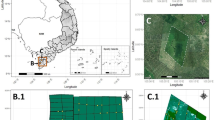Abstract
The use of indigenous plant materials for the construction of biconical traps to control tsetse is described. Preliminary results from field trials indicated that traps made entirely from local materials performed almost as well as a standard design. It is intended to promote the construction and use of these traps on a community self-help basis in sleeping sickness areas of Uganda.
Résumé
L’utilisation des matériaux végétaux dans la fabrication des pièges biconiques pour la lutte contre les mouches tsétsé est expliquée. Les résultats préliminaires des essais sur le terrain indiquent que les pièges fabriqués exclusivement à partir des matériaux locaux sont presque aussi efficaces les modèles standards. Il est recommandé de promouvoir la construction de ces pièges au niveau de la communauté locale des régions frappées par la maladie du sommeil en Ouganda.
Similar content being viewed by others
References
Challier A. and Laveissière C. (1973) Un nouveau piège pour la capteur des glossines (Glossina: Diptera, Mus-cidae). Description et essais sur le terrain. Cah. ORSTOM Sér. ent. méd. Parasit. 11, 251–262.
Eggeling W. J. (1940) The Indigenous Trees of the Uganda Protectorate. Government Printer, Uganda Protectorate.
Kutuza S. K. and Okoth J. O. (1981) A tsetse survey of Luuka and Kigulu counties of South Busoga district, Uganda during an outbreak of African Sleeping Sickness. Bull. Anim. Hlth Prod. 29, 55–58.
Lancien J. (1981) Description du piège monoconique utilise pour l’élimination des glossines en Republique Populaire du Congo. Cah. ORSTOM Sér. ent. méd. Parasit. 19, 235–238.
Langdale-Brown I., Osmaston H. A. and Wilson I. G. (1964) The Vegetation of Uganda and its Bearing on Land Use. Entebbe Government Printer.
Langridge W. P. (1968) Tsetse fly traps and trapping methods. ISCTRC 12th Meeting.
Laveissière C. and Couret D. (1980) Traps impregnated with insecticide for the control of riverine tsetse flies. Trans. R. Soc. trop. Med. Hyg. 74, 264–265.
Lind E. M. and Morrison E. S. (1974) East African Vegetation. Longman, London.
Moloo S. K. (1973) A new trap for Glossina pallidipes Aust. and Glossina fuscipes Newst. (Diptera: Glossinidae). Bull. ent. Res. 63, 231–236.
Okoth J. O. (1985) The resting and breeding sites of Glossina fuscipes fuscipes (Newstead) in relation to Lontana cámara thickets and coffee and banana plantations in the Busoga tsetse fly-belt, Uganda. E. Afr. med. J. In press.
Ryan L. and Molyneux D. H. (1980) In IAEA/FAO International Symposium on the Use of Isotopes for Research and Vectors of Animal Diseases, Host Pathogen Relationships and the Environmental Impact of Control Procedures. Vienna, 7–11 May 1979, IAEA-SM-240/40, pp. 339–353.
United Nations Development Programme/World Bank/World Health Organization Consultation (1982) Control of sleeping sickness due to Trypanosoma brucei gambiense. Bull. Wld Hlth Org. 60, 821–825.
Author information
Authors and Affiliations
Rights and permissions
About this article
Cite this article
Okoth, J.O. The Use of Indigenous Plant Materials for the Construction of Tsetse Traps in Uganda. Int J Trop Insect Sci 6, 569–572 (1985). https://doi.org/10.1017/S1742758400009115
Received:
Revised:
Published:
Issue Date:
DOI: https://doi.org/10.1017/S1742758400009115




